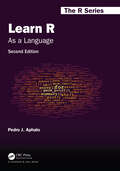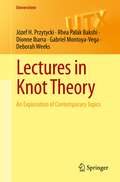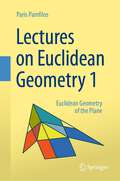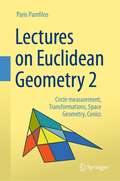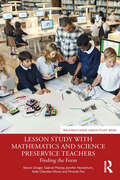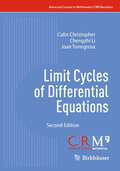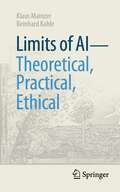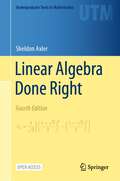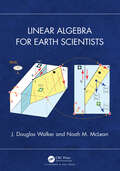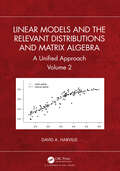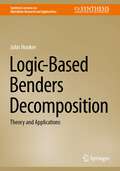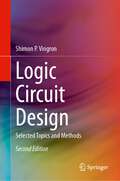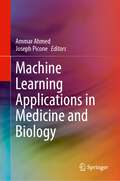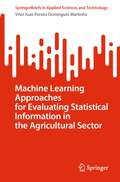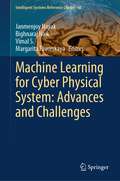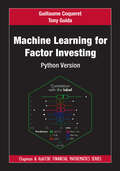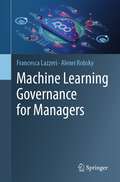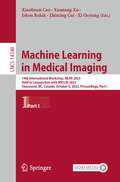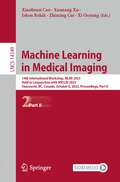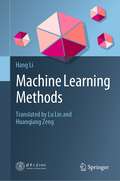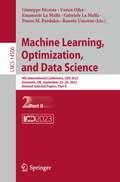- Table View
- List View
Learn R: As a Language (Chapman & Hall/CRC The R Series)
by Pedro J. AphaloLearning a computer language like R can be either frustrating, fun or boring. Having fun requires challenges that wake up the learner’s curiosity but also provide an emotional reward for overcoming them. The book is designed so that it includes smaller and bigger challenges, in what I call playgrounds, in the hope that all readers will enjoy their path to R fluency. Fluency in the use of a language is a skill that is acquired through practice and exploration. For students and professionals in the biological sciences, humanities and many applied fields, recognizing the parallels between R and natural languages should help them feel at home with R. The approach I use is similar to that of a travel guide, encouraging exploration and describing the available alternatives and how to reach them. The intention is to guide the reader through the R landscape of 2024 and beyond.What is new in the second edition? Text expanded by more than 25% to include additional R features and gentler and more detailed explanations Contains 24 new diagrams and flowcharts, seven new tables, and revised text and code examples for clarity All three indexes were expanded, and answers to 28 frequently asked questions added What will you find in this book? Programming concepts explained as they apply to current R Emphasis on the role of abstractions in programming Few prescriptive rules—mostly the author’s preferences together with alternatives Presentation of the R language emphasizing the “R way of doing things” Tutoring for “programming in the small” using scripts for data analysis Explanation of the differences between R proper and extensions for data wrangling The grammar of graphics is described as a language for the construction of data visualisations Examples of data exchange between R and the foreign world using common file formats Coaching to become an independent R user, capable of writing original scripts and solving future challenges
Lectures in Knot Theory: An Exploration of Contemporary Topics (Universitext)
by Józef H. Przytycki Rhea Palak Bakshi Dionne Ibarra Gabriel Montoya-Vega Deborah WeeksThis text is based on lectures delivered by the first author on various, often nonstandard, parts of knot theory and related subjects. By exploring contemporary topics in knot theory including those that have become mainstream, such as skein modules, Khovanov homology and Gram determinants motivated by knots, this book offers an innovative extension to the existing literature. Each lecture begins with a historical overview of a topic and gives motivation for the development of that subject. Understanding of most of the material in the book requires only a basic knowledge of topology and abstract algebra. The intended audience is beginning and advanced graduate students, advanced undergraduate students, and researchers interested in knot theory and its relations with other disciplines within mathematics, physics, biology, and chemistry.Inclusion of many exercises, open problems, and conjectures enables the reader to enhance their understanding of the subject. The use of this text for the classroom is versatile and depends on the course level and choices made by the instructor. Suggestions for variations in course coverage are included in the Preface. The lecture style and array of topical coverage are hoped to inspire independent research and applications of the methods described in the book to other disciplines of science. An introduction to the topology of 3-dimensional manifolds is included in Appendices A and B. Lastly, Appendix C includes a Table of Knots.
Lectures on Euclidean Geometry - Volume 1: Euclidean Geometry of the Plane
by Paris PamfilosThis is a comprehensive two-volumes text on plane and space geometry, transformations and conics, using a synthetic approach. The first volume focuses on Euclidean Geometry of the plane, and the second volume on Circle measurement, Transformations, Space geometry, Conics.The book is based on lecture notes from more than 30 courses which have been taught over the last 25 years. Using a synthetic approach, it discusses topics in Euclidean geometry ranging from the elementary (axioms and their first consequences), to the complex (the famous theorems of Pappus, Ptolemy, Euler, Steiner, Fermat, Morley, etc.). Through its coverage of a wealth of general and specialized subjects, it provides a comprehensive account of the theory, with chapters devoted to basic properties of simple planar and spatial shapes, transformations of the plane and space, and conic sections. As a result of repeated exposure of the material to students, it answers many frequently asked questions. Particular attention has been given to the didactic method; the text is accompanied by a plethora of figures (more than 2000) and exercises (more than 1400), most of them with solutions or expanded hints. Each chapter also includes numerous references to alternative approaches and specialized literature. The book is mainly addressed to students in mathematics, physics, engineering, school teachers in these areas, as well as, amateurs and lovers of geometry. Offering a sound and self-sufficient basis for the study of any possible problem in Euclidean geometry, the book can be used to support lectures to the most advanced level, or for self-study.
Lectures on Euclidean Geometry - Volume 2: Circle measurement, Transformations, Space Geometry, Conics
by Paris PamfilosThis is a comprehensive two-volumes text on plane and space geometry, transformations and conics, using a synthetic approach. The first volume focuses on Euclidean Geometry of the plane, and the second volume on Circle measurement, Transformations, Space geometry, Conics. The book is based on lecture notes from more than 30 courses which have been taught over the last 25 years. Using a synthetic approach, it discusses topics in Euclidean geometry ranging from the elementary (axioms and their first consequences), to the complex (the famous theorems of Pappus, Ptolemy, Euler, Steiner, Fermat, Morley, etc.). Through its coverage of a wealth of general and specialized subjects, it provides a comprehensive account of the theory, with chapters devoted to basic properties of simple planar and spatial shapes, transformations of the plane and space, and conic sections. As a result of repeated exposure of the material to students, it answers many frequently asked questions. Particular attention has been given to the didactic method; the text is accompanied by a plethora of figures (more than 2000) and exercises (more than 1400), most of them with solutions or expanded hints. Each chapter also includes numerous references to alternative approaches and specialized literature. The book is mainly addressed to students in mathematics, physics, engineering, school teachers in these areas, as well as, amateurs and lovers of geometry. Offering a sound and self-sufficient basis for the study of any possible problem in Euclidean geometry, the book can be used to support lectures to the most advanced level, or for self-study.
Lesson Study with Mathematics and Science Preservice Teachers: Finding the Form (WALS-Routledge Lesson Study Series)
This insightful volume offers an overview of the fundamentals of lesson student practice in US teacher education as well as examples from math and science teacher educators using lesson study in their local contexts. The number of teacher educators using lesson study with preservice teachers is small but growing. This book is aimed at teacher educators who may want to try lesson study in university contexts without the challenge of translating the practice from the K-12 context on their own. In this volume, lesson study is broadly overviewed, attention is given to its constituent steps, and examples of lesson study in preservice contexts are shared. Given the broad array of teacher education program designs, numerous contingencies guide teacher educators in their implementation of lesson study, given their contextual affordances and limitations. The lesson study descriptions and cases in this book will support teacher educators and scholars across subject specialities and geographic lines, as they seek instructional frameworks to advance their pedagogical goals.
Lesson Study with Mathematics and Science Preservice Teachers: Finding the Form (WALS-Routledge Lesson Study Series)
by Sharon Dotger Gabriel Matney Jennifer Heckathorn Kelly Chandler-Olcott Miranda FoxThis insightful volume offers an overview of the fundamentals of lesson student practice in US teacher education as well as examples from math and science teacher educators using lesson study in their local contexts. The number of teacher educators using lesson study with preservice teachers is small but growing. This book is aimed at teacher educators who may want to try lesson study in university contexts without the challenge of translating the practice from the K-12 context on their own. In this volume, lesson study is broadly overviewed, attention is given to its constituent steps, and examples of lesson study in preservice contexts are shared. Given the broad array of teacher education program designs, numerous contingencies guide teacher educators in their implementation of lesson study, given their contextual affordances and limitations. The lesson study descriptions and cases in this book will support teacher educators and scholars across subject specialities and geographic lines, as they seek instructional frameworks to advance their pedagogical goals.
Limit Cycles of Differential Equations (Advanced Courses in Mathematics - CRM Barcelona)
by Colin Christopher Chengzhi Li Joan TorregrosaThis textbook contains the lecture series originally delivered at the "Advanced Course on Limit Cycles of Differential Equations" in the Centre de Rechercha Mathematica Barcelona in 2006. It covers the center-focus problem for polynomial vector fields and the application of abelian integrals to limit cycle bifurcations. Both topics are related to the authors' interests in Hilbert's sixteenth problem, but would also be of interest to those working more generally in the qualitative theory of dynamical systems.
Limits of AI - theoretical, practical, ethical (Technik im Fokus)
by Klaus Mainzer Reinhard KahleArtificial intelligence is a key technology with great expectations in science, industry, and everyday life. This book discusses both the perspectives and the limitations of this technology. This concerns the practical, theoretical, and conceptual challenges that AI has to face. In an early phase of symbolic AI, AI focused on formal programs (e.g., expert systems), in which rule-based knowledge was processed with the help of symbolic logic. Today, AI is dominated by statistics-based machine learning methods and Big Data. While this sub-symbolic AI is extremely successful (e.g., chatbots like ChatGPT), it is often not transparent. The book argues for explainable and reliable AI, in which the logical and mathematical foundations of AI-algorithms become understandable and verifiable.
Linear Algebra Done Right (Undergraduate Texts in Mathematics)
by Sheldon AxlerNow available in Open Access, this best-selling textbook for a second course in linear algebra is aimed at undergraduate math majors and graduate students. The fourth edition gives an expanded treatment of the singular value decomposition and its consequences. It includes a new chapter on multilinear algebra, treating bilinear forms, quadratic forms, tensor products, and an approach to determinants via alternating multilinear forms. This new edition also increases the use of the minimal polynomial to provide cleaner proofs of multiple results. Also, over 250 new exercises have been added.The novel approach taken here banishes determinants to the end of the book. The text focuses on the central goal of linear algebra: understanding the structure of linear operators on finite-dimensional vector spaces. The author has taken unusual care to motivate concepts and simplify proofs. A variety of interesting exercises in each chapter helps students understand and manipulate the objects of linear algebra. Beautiful formatting creates pages with an unusually student-friendly appearance in both print and electronic versions. No prerequisites are assumed other than the usual demand for suitable mathematical maturity. The text starts by discussing vector spaces, linear independence, span, basis, and dimension. The book then deals with linear maps, eigenvalues, and eigenvectors. Inner-product spaces are introduced, leading to the finite-dimensional spectral theorem and its consequences. Generalized eigenvectors are then used to provide insight into the structure of a linear operator.From the reviews of previous editions:Altogether, the text is a didactic masterpiece. — zbMATHThe determinant-free proofs are elegant and intuitive. — American Mathematical MonthlyThe most original linear algebra book to appear in years, it certainly belongs in every undergraduate library — CHOICE
Linear Algebra for Earth Scientists
by J. Douglas Walker Noah M. McLeanLinear Algebra for Earth Scientists is written for undergraduate and graduate students in Earth and Environmental sciences. It is intended to give students enough background in linear algebra to work with systems of equations and data in geology, hydrology, geophysics, or whatever part of the Earth Sciences they engage with.The book does not presuppose any extensive prior knowledge of linear algebra. Instead, the book builds students up from a low base to a working understanding of the sub t that they can apply to their work, using many familiar examples in the geosciences.Features Suitable for students of Earth and Environmental Sciences Minimal prerequisites — written in a way that is accessible and engaging for those without a mathematical background All material presented with examples and applications to the Earth Sciences
Linear Algebra for Earth Scientists
by J. Douglas Walker Noah M. McLeanLinear Algebra for Earth Scientists is written for undergraduate and graduate students in Earth and Environmental sciences. It is intended to give students enough background in linear algebra to work with systems of equations and data in geology, hydrology, geophysics, or whatever part of the Earth Sciences they engage with.The book does not presuppose any extensive prior knowledge of linear algebra. Instead, the book builds students up from a low base to a working understanding of the sub t that they can apply to their work, using many familiar examples in the geosciences.Features Suitable for students of Earth and Environmental Sciences Minimal prerequisites — written in a way that is accessible and engaging for those without a mathematical background All material presented with examples and applications to the Earth Sciences
Linear Models and the Relevant Distributions and Matrix Algebra: A Unified Approach Volume 2
by David A. HarvilleLinear Models and the Relevant Distributions and Matrix Algebra: A Unified Approach, Volume 2 covers several important topics that were not included in the first volume. The second volume complements the first, providing detailed solutions to the exercises in both volumes, thereby greatly enhancing its appeal for use in advanced statistics programs. This volume can serve as a valuable reference. It can also serve as a resource in a mathematical statistics course for use in illustrating various theoretical concepts in the context of a relatively complex setting of great practical importance. Together with the first volume, this volume provides a largely self-contained treatment of an important area of statistics and should prove highly useful to graduate students and others. Key Features: Includes solutions to the exercises from both the first and second volumes Includes coverage of several topics not covered in the first volume Highly valuable as a reference book for graduate students and researchers
Linear Models and the Relevant Distributions and Matrix Algebra: A Unified Approach Volume 2
by David A. HarvilleLinear Models and the Relevant Distributions and Matrix Algebra: A Unified Approach, Volume 2 covers several important topics that were not included in the first volume. The second volume complements the first, providing detailed solutions to the exercises in both volumes, thereby greatly enhancing its appeal for use in advanced statistics programs. This volume can serve as a valuable reference. It can also serve as a resource in a mathematical statistics course for use in illustrating various theoretical concepts in the context of a relatively complex setting of great practical importance. Together with the first volume, this volume provides a largely self-contained treatment of an important area of statistics and should prove highly useful to graduate students and others. Key Features: Includes solutions to the exercises from both the first and second volumes Includes coverage of several topics not covered in the first volume Highly valuable as a reference book for graduate students and researchers
Logic-Based Benders Decomposition: Theory and Applications (Synthesis Lectures on Operations Research and Applications)
by John HookerThis book is the first comprehensive guide to logic-based Benders decomposition (LBBD), a general and versatile method for breaking large, complex optimization problems into components that are small enough for practical solution. The author introduces logic-based Benders decomposition for optimization, which substantially generalizes the classical Benders method. It can reduce solution times by orders of magnitude and allows decomposition to be applied to a much wider variety of optimization problems. On the theoretical side, this book provides a full account of inference duality concepts that underlie LBBD, as well as a description of how LBBD can be combined with stochastic and robust optimization, heuristic methods, and decision diagrams. It also clarifies the connection between LBBD and combinatorial Benders cuts for mixed integer programming. On the practical side, it explains how LBBD has been applied to a rapidly growing variety of problem domains. After describing basic theory, this book provides a comprehensive review of the rapidly growing literature that describes these applications, in each case explaining how LBBD is adapted to the problem at hand. In doing so this work provides a sourcebook of ideas for applying LBBD to new problems as they arise.
Logic Circuit Design: Selected Topics and Methods
by Shimon P. VingronThe 2nd edition has been thoroughly revised and is intended as a wakeup call in the stagnant and dormant field of switching algebra and logic circuit design. It presents the material in a concise but thorough way. The topics selected are an in-depth presentation of switching algebra, a theory of memory circuits (sometimes called flop flops), a new approach to asynchronous circuits, and a newly added part presenting a unique programming technique (or language) for programmable logic controllers (PLCs). Be ready for the unorthodox and controversial.
Machine Learning Applications in Medicine and Biology
by Ammar Ahmed Joseph PiconeThis book combines selected papers from the 2022 IEEE Signal Processing in Medicine and Biology Symposium (IEEE SPMB) held at Temple University. The symposium presents multidisciplinary research in the life sciences. Topics covered include:Signal and image analysis (EEG, ECG, MRI)Machine learningData mining and classificationBig data resourcesApplications of particular interest at the 2022 symposium included digital pathology, computational biology, and quantum computing. The book features tutorials and examples of successful applications that will appeal to a wide range of professionals and researchers in signal processing, medicine, and biology.
Machine Learning Approaches for Evaluating Statistical Information in the Agricultural Sector (SpringerBriefs in Applied Sciences and Technology)
by Vitor Joao MartinhoThis book presents machine learning approaches to identify the most important predictors of crucial variables for dealing with the challenges of managing production units and designing agriculture policies. The book focuses on the agricultural sector in the European Union and considers statistical information from the Farm Accountancy Data Network (FADN).Presently, statistical databases present a lot of information for many indicators and, in these contexts, one of the main tasks is to identify the most important predictors of certain indicators. In this way, the book presents approaches to identifying the most relevant variables that best support the design of adjusted farming policies and management plans. These subjects are currently important for students, public institutions and farmers. To achieve these objectives, the book considers the IBM SPSS Modeler procedures as well as the respective models suggested by this software.The book is read by students in production engineering, economics and agricultural studies, public bodies and managers in the farming sector.
Machine Learning for Cyber Physical System: Advances and Challenges (Intelligent Systems Reference Library #60)
by Janmenjoy Nayak Bighnaraj Naik Vimal S. Margarita FavorskayaThis book provides a comprehensive platform for learning the state-of-the-art machine learning algorithms for solving several cybersecurity issues. It is helpful in guiding for the implementation of smart machine learning solutions to detect various cybersecurity problems and make the users to understand in combating malware, detect spam, and fight financial fraud to mitigate cybercrimes. With an effective analysis of cyber-physical data, it consists of the solution for many real-life problems such as anomaly detection, IoT-based framework for security and control, manufacturing control system, fault detection, smart cities, risk assessment of cyber-physical systems, medical diagnosis, smart grid systems, biometric-based physical and cybersecurity systems using advance machine learning approach. Filling an important gap between machine learning and cybersecurity communities, it discusses topics covering a wide range of modern and practical advance machine learning techniques, frameworks, and development tools to enable readers to engage with the cutting-edge research across various aspects of cybersecurity.
Machine Learning for Factor Investing: Python Version (Chapman and Hall/CRC Financial Mathematics Series)
by Guillaume Coqueret Tony GuidaMachine learning (ML) is progressively reshaping the fields of quantitative finance and algorithmic trading. ML tools are increasingly adopted by hedge funds and asset managers, notably for alpha signal generation and stocks selection. The technicality of the subject can make it hard for non-specialists to join the bandwagon, as the jargon and coding requirements may seem out-of-reach. Machine learning for factor investing: Python version bridges this gap. It provides a comprehensive tour of modern ML-based investment strategies that rely on firm characteristics. The book covers a wide array of subjects which range from economic rationales to rigorous portfolio back-testing and encompass both data processing and model interpretability. Common supervised learning algorithms such as tree models and neural networks are explained in the context of style investing and the reader can also dig into more complex techniques like autoencoder asset returns, Bayesian additive trees and causal models. All topics are illustrated with self-contained Python code samples and snippets that are applied to a large public dataset that contains over 90 predictors. The material, along with the content of the book, is available online so that readers can reproduce and enhance the examples at their convenience. If you have even a basic knowledge of quantitative finance, this combination of theoretical concepts and practical illustrations will help you learn quickly and deepen your financial and technical expertise.
Machine Learning for Factor Investing: Python Version (Chapman and Hall/CRC Financial Mathematics Series)
by Guillaume Coqueret Tony GuidaMachine learning (ML) is progressively reshaping the fields of quantitative finance and algorithmic trading. ML tools are increasingly adopted by hedge funds and asset managers, notably for alpha signal generation and stocks selection. The technicality of the subject can make it hard for non-specialists to join the bandwagon, as the jargon and coding requirements may seem out-of-reach. Machine learning for factor investing: Python version bridges this gap. It provides a comprehensive tour of modern ML-based investment strategies that rely on firm characteristics. The book covers a wide array of subjects which range from economic rationales to rigorous portfolio back-testing and encompass both data processing and model interpretability. Common supervised learning algorithms such as tree models and neural networks are explained in the context of style investing and the reader can also dig into more complex techniques like autoencoder asset returns, Bayesian additive trees and causal models. All topics are illustrated with self-contained Python code samples and snippets that are applied to a large public dataset that contains over 90 predictors. The material, along with the content of the book, is available online so that readers can reproduce and enhance the examples at their convenience. If you have even a basic knowledge of quantitative finance, this combination of theoretical concepts and practical illustrations will help you learn quickly and deepen your financial and technical expertise.
Machine Learning Governance for Managers
by Francesca Lazzeri Alexei RobskyMachine Learning Governance for Managers provides readers with the knowledge to unlock insights from data and leverage AI solutions. In today's business landscape, most organizations face challenges in scaling and maintaining a sustainable machine learning model lifecycle. This book offers a comprehensive framework that covers business requirements, data generation and acquisition, modeling, model deployment, performance measurement, and management, providing a range of methodologies, technologies, and resources to assist data science managers in adopting data and AI-driven practices. Particular emphasis is given to ramping up a solution quickly, detailing skills and techniques to ensure the right things are measured and acted upon for reliable results and high performance. Readers will learn sustainable tools for implementing machine learning with existing IT and privacy policies, including versioning all models, creating documentation, monitoring models and their results, and assessing their causal business impact. By overcoming these challenges, bottom-line gains from AI investments can be realized. Organizations that implement all aspects of AI/ML model governance can achieve a high level of control and visibility over how models perform in production, leading to improved operational efficiency and a higher ROI on AI investments. Machine Learning Governance for Managers helps to effectively control model inputs and understand all the variables that may impact your results. Don't let challenges in machine learning hinder your organization's growth - unlock its potential with this essential guide.
Machine Learning in Medical Imaging: 14th International Workshop, MLMI 2023, Held in Conjunction with MICCAI 2023, Vancouver, BC, Canada, October 8, 2023, Proceedings, Part I (Lecture Notes in Computer Science #14348)
by Xiaohuan Cao Xuanang Xu Islem Rekik Zhiming Cui Xi OuyangThe two-volume set LNCS 14348 and 14139 constitutes the proceedings of the 14th International Workshop on Machine Learning in Medical Imaging, MLMI 2023, held in conjunction with MICCAI 2023, in Vancouver, Canada, in October 2023. The 93 full papers presented in the proceedings were carefully reviewed and selected from 139 submissions. They focus on major trends and challenges in artificial intelligence and machine learning in the medical imaging field, translating medical imaging research into clinical practice. Topics of interests included deep learning, generative adversarial learning, ensemble learning, transfer learning, multi-task learning, manifold learning, reinforcement learning, along with their applications to medical image analysis, computer-aided diagnosis, multi-modality fusion, image reconstruction, image retrieval, cellular image analysis, molecular imaging, digital pathology, etc.
Machine Learning in Medical Imaging: 14th International Workshop, MLMI 2023, Held in Conjunction with MICCAI 2023, Vancouver, BC, Canada, October 8, 2023, Proceedings, Part II (Lecture Notes in Computer Science #14349)
by Xiaohuan Cao Xuanang Xu Islem Rekik Zhiming Cui Xi OuyangThe two-volume set LNCS 14348 and 14139 constitutes the proceedings of the 14th International Workshop on Machine Learning in Medical Imaging, MLMI 2023, held in conjunction with MICCAI 2023, in Vancouver, Canada, in October 2023. The 93 full papers presented in the proceedings were carefully reviewed and selected from 139 submissions. They focus on major trends and challenges in artificial intelligence and machine learning in the medical imaging field, translating medical imaging research into clinical practice. Topics of interests included deep learning, generative adversarial learning, ensemble learning, transfer learning, multi-task learning, manifold learning, reinforcement learning, along with their applications to medical image analysis, computer-aided diagnosis, multi-modality fusion, image reconstruction, image retrieval, cellular image analysis, molecular imaging, digital pathology, etc.
Machine Learning Methods
by Hang LiThis book provides a comprehensive and systematic introduction to the principal machine learning methods, covering both supervised and unsupervised learning methods. It discusses essential methods of classification and regression in supervised learning, such as decision trees, perceptrons, support vector machines, maximum entropy models, logistic regression models and multiclass classification, as well as methods applied in supervised learning, like the hidden Markov model and conditional random fields. In the context of unsupervised learning, it examines clustering and other problems as well as methods such as singular value decomposition, principal component analysis and latent semantic analysis. As a fundamental book on machine learning, it addresses the needs of researchers and students who apply machine learning as an important tool in their research, especially those in fields such as information retrieval, natural language processing and text data mining. In order to understand the concepts and methods discussed, readers are expected to have an elementary knowledge of advanced mathematics, linear algebra and probability statistics. The detailed explanations of basic principles, underlying concepts and algorithms enable readers to grasp basic techniques, while the rigorous mathematical derivations and specific examples included offer valuable insights into machine learning.
Machine Learning, Optimization, and Data Science: 9th International Conference, LOD 2023, Grasmere, UK, September 22–26, 2023, Revised Selected Papers, Part II (Lecture Notes in Computer Science #14506)
by Giuseppe Nicosia Varun Ojha Emanuele La Malfa Gabriele La Malfa Panos M. Pardalos Renato UmetonThis book constitutes the refereed proceedings of the 9th International Conference on Machine Learning, Optimization, and Data Science, LOD 2023, which took place in Grasmere, UK, in September 2023. The 72 full papers included in this book were carefully reviewed and selected from 119 submissions. The proceedings also contain 9 papers from and the Third Symposium on Artificial Intelligence and Neuroscience, ACAIN 2023. The contributions focus on the state of the art and the latest advances in the integration of machine learning, deep learning, nonlinear optimization and data science to provide and support the scientific and technological foundations for interpretable, explainable and trustworthy AI.
